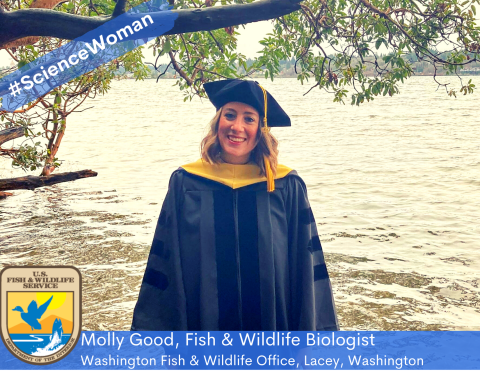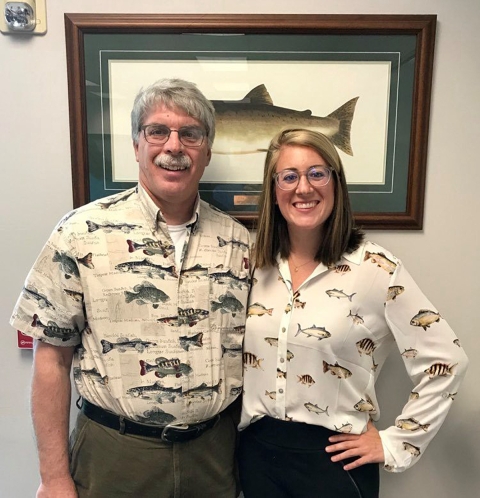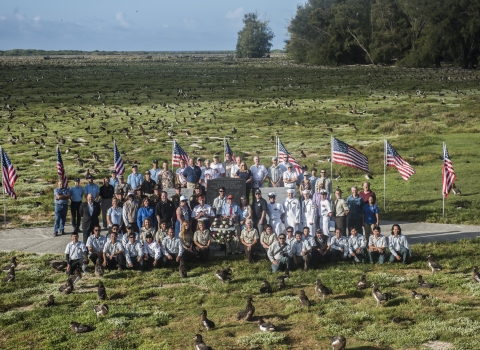My name is Molly Good, and I am a Biologist in the Service’s Ecological Services Program. In this program, Service staff work together and across agencies to administer the Endangered Species Act or ESA, an important law that protects species and habitats. I live and work in western Washington, and I love to fly fish and spend time outdoors.
As part of my regular duties, I promote the increased use of another law, known as the Fish and Wildlife Coordination Act, which limits the degradation of aquatic ecosystems that support species like bull trout and other fishes — especially in the face of major construction projects involving bridges and dams. While the Fish and Wildlife Coordination Act is similar, in some regards, to the ESA, it is distinct. For example, it offers broad conservation coverage for all species and habitats, not just threatened and endangered species and critical habitats. Additionally, the Fish and Wildlife Coordination Act does not require us, as biologists, to produce consultations or Opinions; rather, we produce reports, memos, and letters that often accompany consultations or Opinions.
To implement the Fish and Wildlife Coordination Act, I, obviously, must coordinate regularly with other Federal agencies — like the U.S. Army Corps of Engineers — and non-Federal partners like tribes and universities to leverage resources (e.g., funding, staff) that give our agency a seat at the table — a voice in preserving our federal trust resources; resources that I’m willing to bet all of us care about.
Teamwork Makes the Dream Work
So, with that in mind, I want to share with you a story about the first major, region-wide project I worked on as a FWS employee, where I began learning how to apply all of the instruction I had received in graduate school — from a scientific perspective, but also from a policy, management, and decision-making perspective. As such, this is not a story from what you might consider to be the typical “field,” but the project field, which includes all of the people, agencies, and entities that must often come together to advocate for, and ultimately conserve, species and habitats at the national level.
In early 2018, I received a project request to write and produce a report — mandated by the Fish and Wildlife Coordination Act — that would detail impacts to fish and wildlife species resulting from proposed new operations and maintenance of the Columbia River System Operations. The Columbia River System Operations, or the CRSO, is a complex system, located in the Columbia River basin. It includes multiple projects (i.e., dams, reservoirs, and other associated facilities) that are operated to meet many authorized purposes — one being fish and wildlife conservation, while others include hydropower generation and flood risk management.
As a freshly-minted biologist, I was excited to receive this request — excited about working on something brand new to me, about working in a new area (the Columbia and Snake rivers, wow, like jackpot, am I right?), and about investigating new-to-me species and habitats. I was also anxious — I had neither organized nor written a report like this before, so, I remember thinking, where should I begin? After consulting with some retired staff and digging through old Coordination Act Reports and manuals, I began scoping the project and detailing certain staff roles that I knew we needed to fill.
With financial support from the Corps, our office’s leadership formed a team, which included a project coordinator, a lead report writer, and about ten other Service staff based throughout the Pacific Region. For approximately two years, this team worked closely together to collect data, analyze, and communicate the impacts of the proposed action on a suite of important fish and wildlife species ranging from freshwater mussel species and Pacific lamprey to dunlin and even cottonwoods.
Data Driven Results
One of my favorite memories of working on this project involves our team’s approach to data collection and stakeholder outreach, which we conducted through a series of five region-wide workshops. At each workshop, our coordinator had gathered scientists, managers, academics, non-profit staff, and governmental staff to share information with us. The workshop participants brought different perspectives to our discussions, and it was obvious how valuable their contributions were to our final Coordination Act Report.
For instance, occasionally we had tribal agency staff in the room, and when it came time to discuss fisheries-related issues, their interests were often different from, or more focused than, those of our state or even federal agency staff participants. As an example, I recall ongoing, challenging discussions about how to balance recovery efforts between juvenile fishes and seabirds, who often prey on juvenile fishes in certain areas of the Columbia River. This kind of input or discussion, even though it conflicted sometimes, made our report better and more representative of stakeholders in the region.
In the end, our team completed and produced a final Coordination Act Report, and I was proud. At that point, I recall thinking — I truly just lived out what I had learned in almost a decade of graduate school. The importance of collaboration, using the scientific method, involving the right people, thinking big and creatively, maintaining good ethics, and being a team player.
In addition to the report, a lot of other good things have come out of this project — opportunities to teach Service staff about how to use the Fish and Wildlife Coordination Act and a few informational presentations to external agencies. Of course, a lot of conservation for species and habitats that we often do not normally get to work on. But, the biggest achievement for me and likely for many of our team members, are the relationships we have established within, and outside of, the Service through our work together. I am looking forward to seeing what those relationships bring to all of us in the future.





